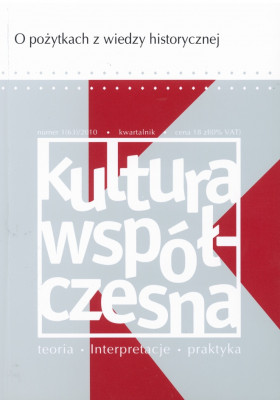Settings and search
O pożytkach z wiedzy historycznej


In this issue of "Kultura Współczesna" we return to the questions of the past and its social images, as well as to its various uses. These problems have constantly been present on all levels of the social discourse always, however, remaining far from being exhausted. In the first part of this issue we are publishing translations of the works of German scholars of memory and the articles of Polish researchers from the Centre of Historical Research of the Polish Academy of Sciences in Berlin, co-operating with them in the framework of the project on Polish and German sites of memory. Remaining texts - with few exceptions - were presented during the seminar organised by the Institute of Cultural Studies of the University of Wrocław in May 2009, entitled "Cultural Studies and the Historical Knowledge," devoted to the problems of the uses of history, historical culture, collective memory and cultural studies of memory. This seminar was co-organised by the Polish Cultural Studies Association and the National Cultural Centre. In at least one respect, this seminar has realised the leading idea of the series of the seminars of "Kultura Współczesna": to combine theoretical, methodological reflection with an analysis of cultural reality.
In the first part of the article, the author defines the notion of historical culture and justifies the reasons for its introduction. In the second part, he discusses the tendencies characteristic for contemporary historical culture, the most important of which seems to be the shift from the paradigm of truth to that of justice.
Middle-Eastern Europe is a region marked by the experiences of both world wars, migrations, communism as well as hybridity resulting from the coexistence on relatively small area of various ethnic and national groups. "The end of the era of the witness" and the proliferation of memory accompanying it introduce question of the mechanisms of reinterpretation of history. The author opposes the political decreeing of memory, asking how is the image of "one's own" and "the other's" past being construed in Middle-Eastern Europe. It is precisely in the reflection on "the other" that he looks for a way out from cul-de-sac of competing national memories.
The author discusses the assumptions, premises and aims of the research project being realised since fall 2006 by the Centre of Historical Research of the Polish Academy of Sciences in Berlin entitled "Polish-German sites of memory", which is an attempt at combining the study of the history of mutual interactions (Beziehungsgeschichte) with the study of the cultures of memory. Its effect would comprise in four volume publication on about one hundred Polish-German sites of memory (planned for 2011).
The article addresses the questions of the status of the concept of cultural memory as an autonomous theory based on interdisciplinary premises. The author expresses doubt both as to the universality of the idea of cultural memory, and to the possibility of the emergence of the notional and methodological consensus between the representatives of various disciplines which undertake the problem of memory. She claims that it seems impossible to pursue the study of memory which would be fully apolitical and independent of generational belonging of the people involved.
The article addresses one of the crucial problems from the realm of collective memory, namely the question of alternation/duration of an image of the past. Applying the theory of German scholar, Aleida Assmann, the author analyses changes in German collective memory in two specific moments of the history of Germany: after the fall of the Third Reich (an example of the application of the strategy of rupture) and after the unification of Germany (strategy of continuation). He discusses the sphere of political celebrations as an important instrument of shaping collective references to the past in the realm of official historical politics (Geschichtspolitik) of the states, and more precisely - change in the calendar of these celebrations after 1945 (mostly in Western Germany) and its modifications after the unification of Germany.
What are the possible uses of the category of "the sites of memory" in cultural studies research on the collective images of the past? An inspiration for the search for answer to the above question has come from the concept of the "history of the second degree" - histoire au second degre - formed in the framework of a big, group research and publication enterprise under the supervision of French historian, Pierre Nota. The key term of this concept - "sites of memory" - however meets with some doubts owing to its specific understanding in the Polish linguistic usage, as well as to its unspecified meaning. The proposition presented in the article aims at such a conceptualisation of the "sites of memory" which would preserve the relationship of the images of the past fixed in the humanistic tradition with spatial objects, but it will not refer solely to the setting or topography of the events. Sites of memory are not perceived here as markers or signals triggering events from the past. Moreover, they are not a "commemoration" whose being is guaranteed exclusively by the decisions of the subjects of "historical politics" (Geschichtspolitik). Thus they consist in such phenomena from the past which have an ability to animate, "crystallise" group memory and produce "symbolic aura," which in the cultural studies position assumed by us means that the site of memory is an image of past events that "means" something very important in the double sense of the word: is semantically rich and is intensely valorised.
The myth of Polish Eastern Borderlands is one of the founding narratives, which construe the identity of the inhabitants of the Lower Silesia resettled here after the Second World War. The article is devoted to the analysis of the phenomena related to the return of memory of the borderlands after the political transformation of the 90'. It is based on the materials gathered during the fieldwork on the sites of memory in Lower Silesia and juxtaposes some contemporary examples of practices of commemoration and mystification of the memory of the past of the borderlands with experiences acquired by those people during their journeys to the former small fatherlands in today's Ukraine, Lithuania or Belorussia.
Christmas Eve table is being treated in this context as a very particular site of memory and the Christmas Eve dishes as the forms of recording of local, familial and individual memory. This table is also a site of meeting and overlapping of different memories and traditions of various members of the family. This analysis is based on the research held in Wrocław in 2007.
Describing particular cases, the author discusses the influence of political change on social construction of the representations of the past on the local level. According to him the fall of Communism has opened to the social actors the possibility of narrating new stories of the past; it has created a chance of using past for active construction of new identities and undertaking individual attempts at becoming deeply ingrained on the lands which have for a long time been treated as temporary place of dwelling.
The text presents an analysis of the Chamber of Memory of the Agriculture of the Parishes of the Śnieżnik Massif established in Bystrzyca Kłodzka in 2002. The narration of the lives of the inhabitants of the villages in the Kłodzko Valley in the last two centuries, reveals a crucial and lived through otherness of the world of the peoples inhabiting this territory before the war and the world of the migrants; it is also a commemoration of their unavoidable confrontation. The author analyses the story of the keeper of the Chamber which points to some common motives of the narration of the past present inhabitants of the Kłodzko Valley.
The author presents Augustyn Czyżowicz, the "guard of memory," and a photographer of everyday and festive life of the Lower Silesian village in the period 1956-1960. She is interested in the relationship between the memory - what is remembered from the past (Sąsiadowice), and what one needs to commemorate - and photography. Discovered anew owing to interviews held by the group of cultural studies scholars (Barbaruk, Topp, Fereński) collection of Czyzowicz's photographs does not, according to the author, provide a "document of the era," but rather bears traits of artistic photography (creating the names of the series, interference with an image on the photographic film, staging of the photos), which in turn has some clear links to memory. The link to the memory is also establish by Czyzowicz's way of looking at Lower Silesian landscape (the so-called memory of work and the influence of painting).
The article describes the history of the formation of the society of Wałbrzych in the period of grand changes between 1945-1948. Focus on such a small territory of the people diversified mentally, coming from the former Borderlands and Western Europe, has caused conflicts as a result of differently shaped world views, including different attitude towards Catholic Church and Communism, as well as trigger slow integration of social groups.
The article is a record of a reading of the space of Warsaw on the axis of John Paul II Avenue and Stawki Street ending on nearby Krasiński Square, which presents some basic symbolic loops as well as an image of collective memory and identity in crisis. It is focused on the question whether the tools worked out by American theoreticians of posttraumatic culture find their use on the Polish grounds (the world "grounds" is understood here both literally and metaphorically). It is an attempt at polemics with the concept of "unassimilated memory" of Michael C. Steinlauf.
The article is a discussion of the project realised by Paweł Brożek on Facebook.com, commemorating a Jewish boy, Henio Żytomirski, murdered in Majdanek in November 1942. Here, the social networking site becomes a space for the process of creation of postmemory (Marianne Hirsch), whose centre is provided by the photographs of Henio, digitalised and made accessible in his fictitious Internet profile. The article stresses the importance of the communication within virtual community in the process of working through of the trauma of the experience of emptiness: in the framework of this collective, the internet users gain mutual confidence as to the real character of Henio; together they try to deal with emotions caused by his (non)presence among the living. An important context for the problem touched upon in the article is also a question of the limits of commemoration in the space of Internet: is contact with digital reproduction, ontologically similar to the computer-generated graphics, important for the work of postmemory?
